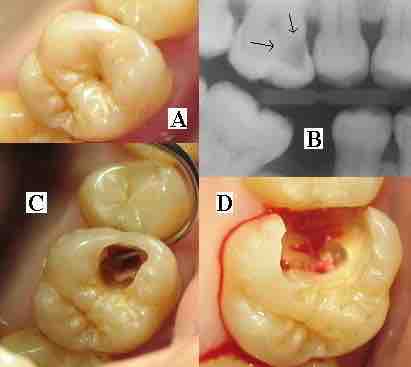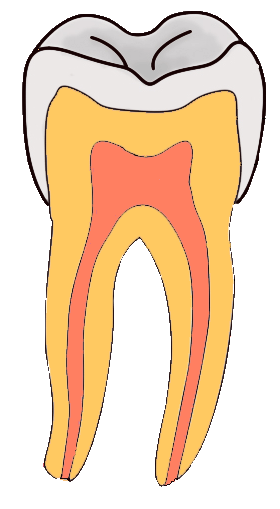Dental caries, also known as tooth decay or a cavity, is an infection, usually bacterial in origin, that causes demineralization of the hard tissues (enamel, dentin, and cementum) and destruction of the organic matter of the tooth, usually by production of acid by hydrolysis of the food debris accumulated on the tooth surface. If demineralization exceeds saliva and other remineralization factors such as from calcium and fluoridated toothpastes, these tissues progressively break down, producing dental caries (cavities, holes in the teeth) . The two bacteria most commonly responsible for dental cavities are Streptococcus mutans and Lactobacillus. If left untreated, the disease can lead to pain, tooth loss, and infection. Today, caries remain one of the most common diseases throughout the world.
Caries can be classified by location, etiology, rate of progression, and affected hard tissues. These forms of classification can be used to characterize a particular case of tooth decay in order to more accurately represent the condition to others and also indicate the severity of tooth destruction.
Tooth decay disease is caused by specific types of bacteria that produce acid in the presence of fermentable carbohydrates such as sucrose, fructose, and glucose. The mineral content of teeth is sensitive to increases in acidity from the production of lactic acid. To be specific, a tooth (which is primarily mineral in content) is in a constant state of back-and-forth demineralization and remineralization between the tooth and surrounding saliva. For people with little saliva, especially due to radiation therapies that may destroy the salivary glands, there also exists remineralization gel. These patients are particularly susceptible to dental caries. When the pH at the surface of the tooth drops below 5.5, demineralization proceeds faster than remineralization (meaning that there is a net loss of mineral structure on the tooth's surface). Most foods are in this acidic range and without remineralization result in the ensuing decay.
As the enamel and dentin are destroyed, the cavity becomes more noticeable . The affected areas of the tooth change color and become soft to the touch. Once the decay passes through enamel, the dentinal tubules, which have passages to the nerve of the tooth, become exposed, causing a toothache. The pain may worsen with exposure to heat, cold, or sweet foods and drinks. Dental caries can also cause bad breath and foul tastes. In highly progressed cases, infection can spread from the tooth to the surrounding soft tissues. Complications such as cavernous sinus thrombosis and Ludwig's angina can be life-threatening.

Dental caries
(A) A small spot of decay visible on the surface of a tooth. (B) The radiograph reveals an extensive region of demineralization within the dentin (arrows). (C) A hole is discovered on the side of the tooth at the beginning of decay removal. (D) All decay removed.
There are four main criteria required for caries formation: a tooth surface (enamel or dentin) caries-causing bacteria, fermentable carbohydrates (such as sucrose), and time. The caries process does not have an inevitable outcome, and different individuals will be susceptible to different degrees depending on the shape of their teeth, oral hygiene habits, and the buffering capacity of their saliva. Dental caries can occur on any surface of a tooth that is exposed to the oral cavity, but not the structures that are retained within the bone. All caries occur from acid demineralization that exceeds saliva and fluoride remineralization, and almost all acid demineralization occurs where food (containing carbohydrate like sugar) is left on teeth. Though most trapped food is left between teeth, over 80% of cavities occur inside pits and fissures on chewing surfaces where brushing, fluoride, and saliva cannot reach to remineralize the tooth as they do on easy-to-reach surfaces that develop few cavities.
In most people, disorders or diseases affecting teeth are not the primary cause of dental caries. Ninety-six percent of tooth enamel is composed of minerals. These minerals, especially hydroxyapatite, will become soluble when exposed to acidic environments. Enamel begins to demineralize at a pH of 5.5. Dentin and cementum are more susceptible to caries than enamel because they have lower mineral content. Thus, when root surfaces of teeth are exposed from gingival recession or periodontal disease, caries can develop more readily. Even in a healthy oral environment, however, the tooth is susceptible to dental caries.
Bacteria in a person's mouth convert glucose, fructose, and most commonly sucrose (table sugar) into acids such as lactic acid through a glycolytic process called fermentation. If left in contact with the tooth, these acids may cause demineralization, which is the dissolution of its mineral content. The process is dynamic, however, as remineralization can also occur if the acid is neutralized by saliva or mouthwash.
At times, pit and fissure caries may be difficult to detect . Bacteria can penetrate the enamel to reach dentin, but then the outer surface may remineralize, especially if fluoride is present. These caries, sometimes referred to as "hidden caries", will still be visible on x-ray radiographs, but visual examination of the tooth would show the enamel intact or minimally perforated.

Pit and fissure caries.
The progression of pit and fissure caries resembles two triangles with their bases meeting along the junction of enamel and dentin.